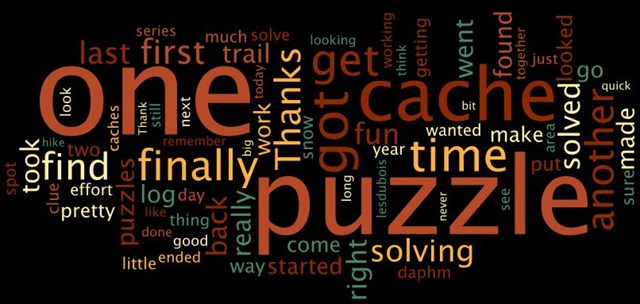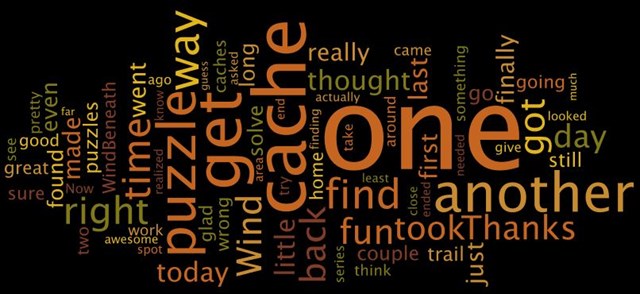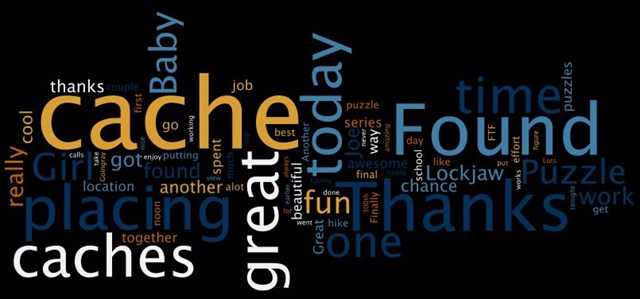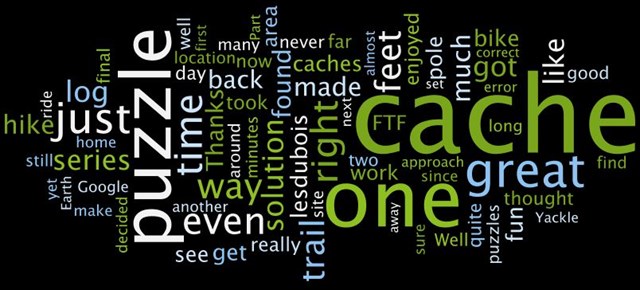This cache sits at the root of a figurative tree of caches. It directly depends on these six puzzle caches:
Cache A. Canyon Conundrum
Cache B. Urban Unknown
Cache C. Summer Stumper
Cache D. Educational Enigma
Cache E. Puzzle Parade
Cache F. Quixotic Quandary
Each of the six caches on this list depends (or will depend) on six other puzzle caches. When Quixotic Quandary is complete, there will be 43 puzzle caches in the Meta Mystery ancestor tree.
I placed the first cache in the tree, In Loving Memory, on October 15, 2006. This was so long ago that it was himilecyclist's first FTF, a fact that he noted in a log that was only 42 words long. I originally expected that I'd be finished with all 43 caches by the end of 2007. Obviously, I underestimated how long it would take!
One of the great pleasures in placing all of these puzzles has been enjoying the logs that the finders have left behind. I will sometimes go back and read old logs just to reminisce a bit. Thanks to everyone who has contributed their thoughts to my cache pages!
On October 20, 2013, I identified the four cachers who had found the most Meta Mystery caches. For each cacher, I took all of their log entries for those caches and used them to create a word cloud. Each cacher's word cloud displays the 75 words (excluding very common words such as "the") that were most frequently used in that cacher's logs. The relative sizes of the words in the cloud correspond to the relative frequencies with which the words were used. Not surprisingly, the word "cache" occurs frequently in all four cases. The word clouds appear below.
Cloud 1. 
Cloud 2. 
Cloud 3. 
Cloud 4. 
To learn the coordinates of Meta Mystery, you must first visit the six caches listed above and retrieve the key that each contains. Every key is the name of a person. We'll use Name A to stand for the key in Cache A, Name B for the key in Cache B, and so on.
Once you have the names of the six people, you must figure out why they all belong on the same list of distinction. You must then determine the year during which each first qualified for the list. We'll let Year A stand for the year that Name A qualified for the list, and so forth.
You must also figure out which cacher's logs I used to produce each word cloud. We'll use Cacher 1 to stand for the caching name of the cacher who is the subject of Cloud 1, and similarly for the other clouds. (Important: Use the name that the cacher was using on October 20, 2013. For example, if you believe that Seawind is one of the cachers, you should use his original caching name of himilecyclist.)
Once you've determined Names A through F, Years A through F, and Cachers 1 through 4, you'll have demonstrated your cleverness and puzzle-solving savvy. At that point you'll need to show that you can behave like a computer by following the detailed directions below.
A string is a sequence of letters, such as "John" or "help". When I tell you to encode a string, replace each letter in the string with the last five bits of the ASCII code for that letter. For example, "John" encodes as "01010011110100001110".
Fill out the table below as follows:
- Encode the first four letters of the last name of Name A and write the resulting 20 bits into its row. (For Franklin Roosevelt you would encode "Roos".)
- Do the same for Names B through F.
- Form a six-digit number by appending the last digit of Year A, the last digit of Year B, and so on. Convert this number into base 2 and write the resulting 20 bits into the row labeled "Years". (If Year A is 1958, Year B is 1856, Year C is 1977, Year D is 1952, Year E is 1923, and Year F is 1945, you would convert 867235 into base 2.
- Form a string by appending the first letter of Cacher 1, the first letter of Cacher 2, the first letter of Cacher 3, and the first letter of Cacher 4. Encode this string and write the resulting 20 bits into the row labeled First Letters. (If Cacher 1 is "Smith", Cacher 2 is "Anchor Steam", Cacher 3 is "pygmalion", and Cacher 4 is "HowdyDoody", you would encode "SApH".)
- Form a string by appending the second letters of Cachers 1 through 4. Encode this string and write the resulting 20 bits into the row labeled Second Letters. (Using the cacher names above, you would encode "mnyo".)
- Form a string by appending the third letters of Cachers 1 through 4. Encode this string and write the resulting 20 bits into the row labeled Third Letters. (In the example above, you would encode "icgw".)
- Form a string by appending the fourth letters of Cachers 1 through 4. Encode this string and write the resulting 20 bits into the row labeled Fourth Letters. (In the example above, you would encode "thmd".)
- Write 0's and 1's into the Parity row of the table to make it so that each column contains an even number of 1's.
| Name A |
|
|
|
|
|
|
|
|
|
|
|
|
|
|
|
|
|
|
|
|
| Name B |
|
|
|
|
|
|
|
|
|
|
|
|
|
|
|
|
|
|
|
|
| Name C |
|
|
|
|
|
|
|
|
|
|
|
|
|
|
|
|
|
|
|
|
| Name D |
|
|
|
|
|
|
|
|
|
|
|
|
|
|
|
|
|
|
|
|
| Name E |
|
|
|
|
|
|
|
|
|
|
|
|
|
|
|
|
|
|
|
|
| Name F |
|
|
|
|
|
|
|
|
|
|
|
|
|
|
|
|
|
|
|
|
| Years |
|
|
|
|
|
|
|
|
|
|
|
|
|
|
|
|
|
|
|
|
| First Letters |
|
|
|
|
|
|
|
|
|
|
|
|
|
|
|
|
|
|
|
|
| Second Letters |
|
|
|
|
|
|
|
|
|
|
|
|
|
|
|
|
|
|
|
|
| Third Letters |
|
|
|
|
|
|
|
|
|
|
|
|
|
|
|
|
|
|
|
|
| Fourth Letters |
|
|
|
|
|
|
|
|
|
|
|
|
|
|
|
|
|
|
|
|
|
| Parity |
|
|
|
|
|
|
|
|
|
|
|
|
|
|
|
|
|
|
|
|
Convert the 20-bit binary number in the Parity row to base 10, then divide it by 360. The quotient will be of the form X.Y (where the '.' is a decimal point).
You will find the cache X meters from the posted coordinates at a heading of (360 times .Y) degrees.
It does not contain a clue.